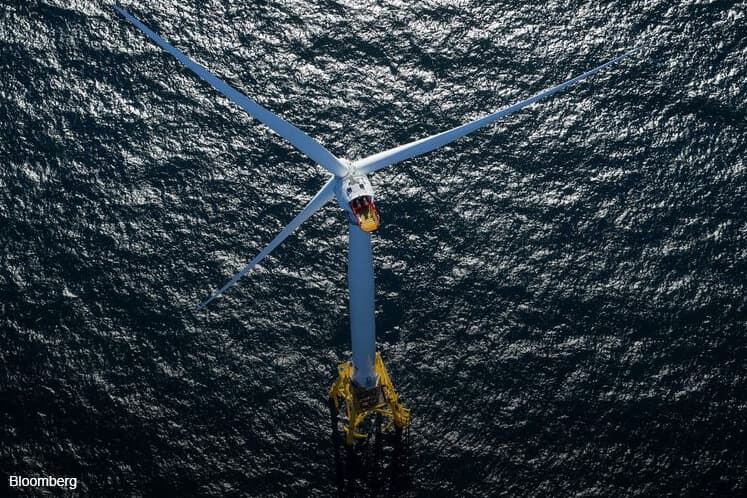
WATER and electric power plants do not mix well naturally, unless you add some wind.
Water tends to corrode and short out circuits. So what is happening in the renewable energy industry, where developers are putting jumbo-jet sized wind turbines into stormy seas, is at the very least an engineering miracle.
What might be even more miraculous to sceptics like those populating US President Donald Trump’s administration is that these multibillion-dollar mega projects make increasing economic sense, even compared to new coal and nuclear power.
“If you have a sufficiently large site with the right wind speeds, then I do believe you can build offshore wind at least at the same price as new build coal in many places around the world including the US,” said Henrik Poulsen, chief executive officer of Dong Energy A/S, the Danish utility that has pioneered the technology and has become the world’s biggest installer of windmills at sea.
Across Europe, the price of building an offshore wind farm has fallen 46% in the last five years — 22% last year alone. Erecting turbines in the seabed now costs an average US$126 (RM561.96) for each megawatt-hour of capacity, according to Bloomberg New Energy Finance. That is below the US$155 a megawatt-hour price for new nuclear developments in Europe and closing in on the US$88 price tag on new coal plants, the London-based researcher estimates.
As nuclear power costs spiral, prompting a US$6.3 billion write-down at reactor maker Toshiba Corp and delays at Electricite de France SA’s plant in Flamanville, the investment needed to build offshore wind capacity is plummeting.
In Denmark, where the government shoulders much of the development risk, Vattenfall AB last year agreed to supply power from turbines in the North Sea at €60 a megawatt-hour in 2020. Dutch and German auctions due this year provide “ample opportunity” to beat that record low price, says Gunnar Groebler, the utility’s head of wind.
The industry even is taking hold in the US. A federal auction in December for rights to develop wind farms off the coast of Long Island resulted in a bidding war. Rhode Island has commissioned one plant, and developers are also considering work in Maryland, New Jersey and North Carolina.
The US government’s official goal for now is to install 86 gigawatts of turbines at sea by 2050. That is six times the 14 gigawatts of capacity now in place worldwide, according to the Global Wind Energy Council.
Fixing the machines to the seabed requires deep concrete footings cast in often turbulent seas.
Oil majors that have spent decades building skills to work in those conditions are turning their attention to offshore wind as petroleum production subsides in the North Sea. Royal Dutch Shell plc and Statoil ASA are among companies that won contracts to build offshore wind projects last year.
All told, a record US$29.9 billion was invested in offshore wind in 2016, up 40% from the year before, according to Bloomberg New Energy Finance. It expects investment to grow to US$115 billion by 2020. What is driving installations is an expected 26% drop in the costs, making offshore wind increasingly competitive with land-based turbines and solar and nuclear power — even without subsidy.
In years past, grid managers were reluctant to rely on fickle winds for power that flows only about 45% of the year. That is changing too. Battery costs have fallen 40% since 2014, making them a realistic way to help balance fluctuating flows of renewable energy to the grid.
Offshore wind projects coming online today are already delivering power at almost half the price of those finished in 2012 thanks to larger turbines and greater competition. That is emboldening developers to promise supplying power for even less, suggesting the industry will break more records this year starting a contest in Germany in April, said Deepa Venkateswaran, analyst at Sanford C Bernstein Ltd.
The UK remains one of the hottest markets owing to the need to replace ageing power plants. Bids may reach as little as €80 a megawatt-hour in the next auction due to start in April, she said. That is comparable to about £68 a megawatt-hour for the global onshore wind average, and well below the government’s 2020 goal to bring costs below £100 ($125.55) a megawatt-hour.
It is also much cheaper than EDF’s new nuclear power programme at Hinkley Point in Somerset, which last year won a 35-year contract to provide power at a cost of £92.50 a megawatt hour once it begins generating. It is currently due to come online in 2026, even though EDF originally planned it to be cooking Christmas turkeys for British households in 2017.
“In this auction it is possible that the price achieved could be below £90,” said Keith Anderson, chief corporate officer of Scottish Power Ltd, a unit of Spain’s Iberdrola SA. — Bloomberg